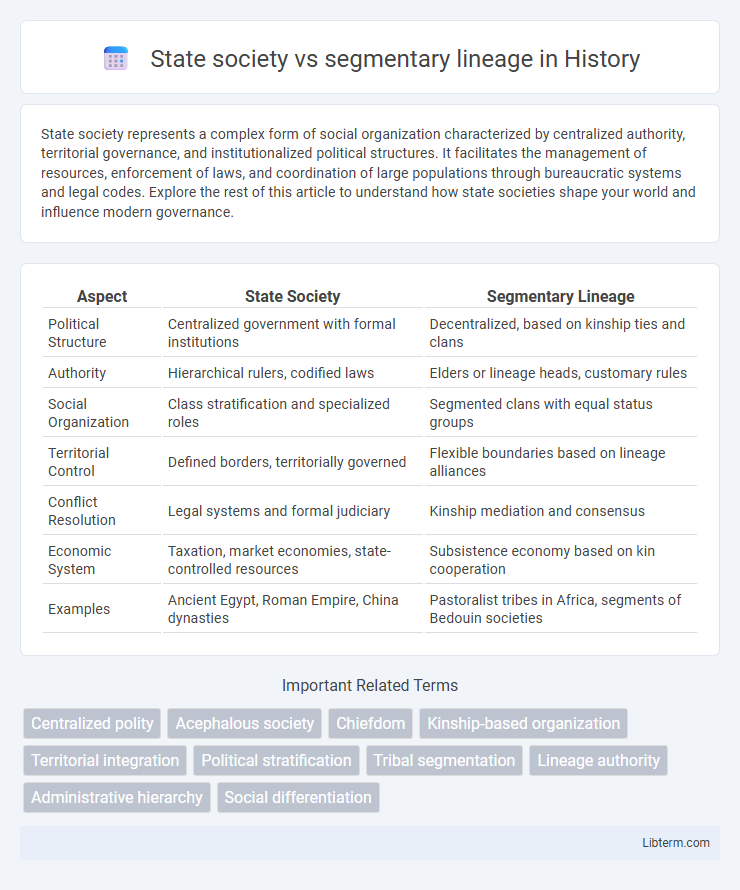State society represents a complex form of social organization characterized by centralized authority, territorial governance, and institutionalized political structures. It facilitates the management of resources, enforcement of laws, and coordination of large populations through bureaucratic systems and legal codes. Explore the rest of this article to understand how state societies shape your world and influence modern governance.
Table of Comparison
| Aspect | State Society | Segmentary Lineage |
|---|---|---|
| Political Structure | Centralized government with formal institutions | Decentralized, based on kinship ties and clans |
| Authority | Hierarchical rulers, codified laws | Elders or lineage heads, customary rules |
| Social Organization | Class stratification and specialized roles | Segmented clans with equal status groups |
| Territorial Control | Defined borders, territorially governed | Flexible boundaries based on lineage alliances |
| Conflict Resolution | Legal systems and formal judiciary | Kinship mediation and consensus |
| Economic System | Taxation, market economies, state-controlled resources | Subsistence economy based on kin cooperation |
| Examples | Ancient Egypt, Roman Empire, China dynasties | Pastoralist tribes in Africa, segments of Bedouin societies |
Introduction to State Society and Segmentary Lineage
State societies are complex political organizations characterized by centralized authority, formal institutions, and hierarchical governance overseeing defined territories. Segmentary lineage systems operate through kinship-based social structures where segments or clans maintain autonomous control without centralized political power. Understanding these differing social organizations illuminates variations in governance, social cohesion, and conflict resolution mechanisms across cultures.
Defining State Society: Key Features
State society is characterized by centralized authority, a formal government structure, and institutionalized laws governing a defined territory. It features hierarchical social stratification, specialized roles, and a bureaucracy that administers complex economic and legal systems. Unlike segmentary lineage systems, state societies maintain social order through codified rules and centralized enforcement mechanisms.
Understanding Segmentary Lineage: Core Characteristics
Segmentary lineage systems are social structures organized around kinship groups linked by common ancestry, functioning without centralized political authority. These systems rely on segmentary groups that operate autonomously but unite during external threats or conflicts, maintaining social cohesion through shared descent. Unlike state societies, segmentary lineages emphasize decentralized governance, consensus decision-making, and fluid alliances between segments rather than formal institutions or bureaucratic control.
Historical Origins and Evolution
State societies originated with the rise of centralized governments and complex institutions around 3000 BCE, marked by urbanization and codified legal systems. Segmentary lineage societies developed earlier, often in nomadic or pastoralist communities, characterized by decentralized kinship-based groups without formal political hierarchies. The evolution of state societies involved increased social stratification and bureaucratic administration, whereas segmentary lineages maintained flexible allegiances and egalitarian social relations.
Social Organization and Governance Structures
State societies feature centralized governance with hierarchical institutions, formal laws, and bureaucratic administration, enabling complex social stratification and resource control. Segmentary lineage societies operate through decentralized kinship-based groups, where social organization relies on lineage ties and consensus decision-making without formalized authority or codified laws. Governance in state societies enforces regulations and tax systems, whereas segmentary lineage societies resolve conflicts through customary practices within kin networks.
Authority, Power, and Leadership Patterns
State societies centralize authority in formal institutions such as bureaucracies and legal systems, allowing rulers to exert power through codified laws and administrative control. Segmentary lineage societies distribute power across kinship groups, with leadership often based on consensus and achieved status rather than hierarchical command. Leadership in segmentary lineage systems is flexible and situational, relying heavily on social ties and customary norms rather than fixed political structures.
Mechanisms of Conflict Resolution
State societies employ centralized legal systems and formal institutions such as courts and law enforcement to resolve conflicts, ensuring standardized enforcement of laws. Segmentary lineage societies rely on kinship-based mechanisms, including mediation by elders and negotiation among clans, to manage disputes through consensus and reciprocal obligations. The contrast highlights state societies' focus on codified laws versus segmentary lineages' emphasis on social cohesion and lineage alliances for conflict resolution.
Economic Systems and Resource Management
State societies employ centralized economic systems characterized by taxation, market regulation, and state-controlled resource allocation to sustain complex infrastructures and urban centers, promoting surplus production and labor specialization. Segmentary lineage societies rely on kin-based, non-centralized economic organization, where resource management is communal and decisions about land use or resource distribution are made through consensus among lineage segments. The efficiency of state economies in resource mobilization contrasts with the flexible, adaptive resource sharing mechanisms prevalent in segmentary lineage structures.
Case Studies: Examples from Anthropology
State societies exhibit centralized political institutions and stratified social hierarchies, as demonstrated in the ancient Mesopotamian city-states where bureaucratic governance and codified laws maintained social order. In contrast, segmentary lineage societies, such as the Nuer of Sudan, operate through decentralized kin-based segments that resolve conflicts and organize social life without centralized authority. Anthropological case studies highlight how these distinct social structures influence conflict resolution methods and political organization.
Comparative Analysis: State Society vs. Segmentary Lineage
State societies exhibit centralized authority, codified laws, and institutionalized governance structures, promoting social stratification and complex bureaucracies. Segmentary lineages rely on kinship-based organization, lacking centralized control, with social order maintained through affiliation and conflict resolution within genealogical segments. The fundamental contrast lies in state societies' institutionalized legal systems versus the segmentary lineage's flexible, kinship-driven mechanisms of social cohesion and authority.
State society Infographic

 libterm.com
libterm.com